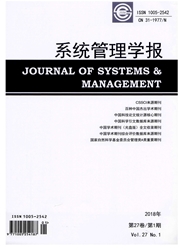

 中文摘要:
中文摘要:
在设施选址中,客户的需求往往是不确定的,用模糊变量来描述不确定需求更能真实地模拟出决策过程。在模糊可信性理论的基础上,建立了基于模糊需求的单货源多设施Weber问题优化模型,并结合改进的重心法(ALA)与两阶段优化算法,设计了一种新的混合启发式算法。该算法建立了客户的优先级,通过不断更新设施容量和设施位置来实现对客户分配,为了防止陷入局部最优,首先利用改进的重心法来优化初始选址位置(实质上是局部优化),然后用PSO算法进行全局优化。对小规模的问题,分别采用精确算法和本文提出的启发式算法求解,发现算法是有效的,并且具有良好的性能。将该模型和启发式算法应用到大牛地气田污水处理厂选址中,当客户为58,设施个数为6,种群大小为40时,该算法在375代左右收敛,年污水配送费用从360万元减少到312万元。该模型和算法对于进一步补充和完善设施选址模型具有重要意义,在现实中对于不确定需求决策具有一定的应用价值。
 英文摘要:
英文摘要:
In the facility location problem, the demands of customers are often uncertain. The decision- making process can be modelled more realistically if fuzzy variables are used to describe the uncertain demand. Based on the fuzzy credibility theory, we propose a Single-source Capacitated Multi-facility Weber Problem with Fuzzy Demand (SSCMFWPFD) optimization model and design a new heuristic algorithm to solve the model. The alogorithm establishes the customer priority, and continuously updated facility capacity and location to achieve the customer allocation. In order to prevent local convergence, firstly, an improved method of gravity local search is used to optimize the initial particle, and then PSO algorithm is used for global optimization. By using precise algorithms and heuristics for small-scale problem, we find that the heuristic algorithm is effective and has good performance. Integrating the new model and heuristic
 同期刊论文项目
同期刊论文项目
 同项目期刊论文
同项目期刊论文
 Comparative study on economic contribution rate of education of China and foreign countries based on
Comparative study on economic contribution rate of education of China and foreign countries based on 期刊信息
期刊信息
